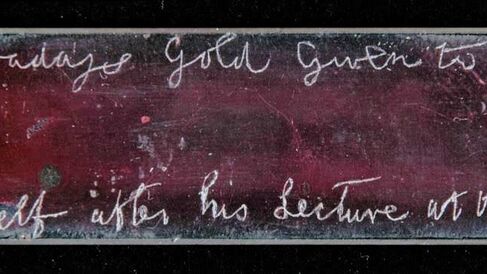Michael Faraday's Microscope Slide

This slide was used in a lecture by Michael Faraday (1791-1867), to illustrate his work on colloids (mixtures of two substances). Faraday would have shown the slide by using a projecting microscope. This pre-prepared experiment was typical of Faraday's lectures, which became famous and were attended by Prince Albert, among other wealthy and famous members of Victorian society.
Pocket electronic calculators were not necessarily bought for their utility alone. A number of manufacturers focused on making calculators that appealed to the aesthetic sensibilities of their users. Some were designed to promote the instrument's value and exclusivity, whilst others, in a manner similar to certain slide rules and mechanical calculators before them, sought to imitate other handheld objects to assert their convenience.
Although the Whipple Museum does not have any live frogs or zoological specimens within its collection, it does have many frog-related objects. Why would this be? This section examines the links between frogs and scientific practice, and the contribution that this common amphibian has made to scientific knowledge.
Gold "sols"
"Faraday[']s Gold Given to me himself after his lecture at the RI [Royal Institution.]"
This inscription is scratched directly onto the slide; the occasion was probably the lecture given on June 12th 1858, entitled 'On the relation of Gold to Light'. Faraday was famous for his captivating lectures featuring superbly choreographed demonstrations, and would have used a projecting microscope to show the slide.
"Faraday's Gold" is in fact a colloid, a material that is a mixture of two or more solids, liquids, or gases together. The particular type of colloid that Faraday was interested in was a dispersion of very fine gold particles suspended in a liquid. This type of preparation is known as a colloidal suspension or, as Faraday named it, a gold "sol". Other more familiar examples of sols include paint, mud, and toothpaste. The particles of gold present in the sol are on the nanometre scale - each is one billionth of a metre in length.
Faraday's experiments
Gold sols had been known to alchemists in the 17th century, but Faraday was the first to present a scientific paper on their properties and preparation. The preparations of gold sols that Faraday studied were ruby-red in colour: "part of the gold is reduced in exceedingly fine particles, which becoming diffused, produce a beautiful ruby fluid."(1)
Faraday discovered that he could turn the preparation blue by adding certain salts. Gold sols also coagulated when salts were added, although this could be prevented by the addition of gelatin.
Faraday made some attempt to explain what was causing the vivid colouration in his gold mixtures, saying that "known phenomena seemed to indicate that a mere variation in the size of [gold] particles gave rise to a variety of resultant colours."(2) He did not explain why changing the size of the gold particles altered the colour, but described his work as "a useful experimental entrance into certain physical investigations respecting the nature and action of a ray of light."(3)
References
Ruth Horry & Boris Jardine
Ruth Horry & Boris Jardine, 'Michael Faraday's microscope slide', Explore Whipple Collections, Whipple Museum of the History of Science, University of Cambridge, 2008.
